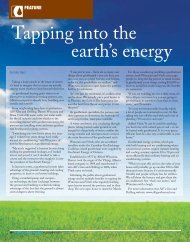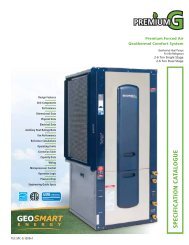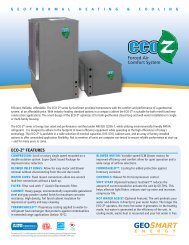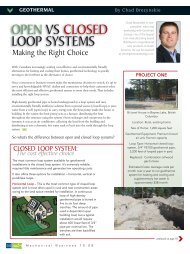Premium G Install Manual - GeoSmart Energy
Premium G Install Manual - GeoSmart Energy
Premium G Install Manual - GeoSmart Energy
Create successful ePaper yourself
Turn your PDF publications into a flip-book with our unique Google optimized e-Paper software.
PREMIUM G SERIES INSTALLATION MANUAL<br />
Unit Startup<br />
Before Powering Unit, Check the Following:<br />
NOTE: Remove and discard the compressor hold down shipping bolt<br />
located at the front of the compressor mounting bracket.<br />
• High voltage is correct and matches nameplate.<br />
• Fuses, breakers and wire size correct.<br />
• Low voltage wiring complete.<br />
• Piping completed and water system cleaned and flushed.<br />
• Air is purged from closed loop system.<br />
• Isolation valves are open, water control valves or loop<br />
pumps wired.<br />
• Condensate line open and correctly pitched.<br />
• Transformer switched to 208V if applicable.<br />
• Black/white and gray/white wires in unit control box have been<br />
removed if auxiliary heat has been installed.<br />
• Dip switches are set correctly.<br />
• Hot water generator pump switch is “OFF” unless piping is<br />
completed and air has been purged.<br />
• Blower rotates freely.<br />
• Blower speed is correct.<br />
• Air filter/cleaner is clean and in position.<br />
• Service/access panels are in place.<br />
• Return air temperature is between 50-80°F heating and<br />
60-95°F cooling.<br />
• Check air coil cleanliness to ensure optimum performance.<br />
Clean as needed according to maintenance guidelines. To<br />
obtain maximum performance the air coil should be cleaned<br />
before startup. A 10% solution of dishwasher detergent and<br />
water is recommended for both sides of coil, a thorough water<br />
rinse should follow.<br />
9. Adjust the cooling setpoint above the room temperature and verify<br />
that the compressor and water valve or loop pumps deactivate.<br />
10. Initiate a control signal to place the unit in the heating mode.<br />
Heating set point must be set above room temperature.<br />
11. First stage heating will energize after a time delay.<br />
12. Check the temperature of both the supply and discharge water<br />
(see the Unit Operating Parameters tables).<br />
13. Check for an air temperature rise of 12°F to 35°F across the air<br />
coil, depending on the fan speed and entering water temperature.<br />
14. If auxiliary electric heaters are installed, increase the heating<br />
setpoint until the electric heat banks are sequenced on. All<br />
stages of the auxiliary heater should be sequenced on when the<br />
thermostat is in the Emergency Heat mode. Check amperage of<br />
each element.<br />
15. Adjust the heating setpoint below room temperature and verify<br />
that the compressor and water valve or loop pumps deactivate.<br />
16. During all testing, check for excessive vibration, noise or water<br />
leaks. Correct or repair as required.<br />
17. Set system to desired normal operating mode and set<br />
temperature to maintain desired comfort level.<br />
18. Instruct the owner/operator in the proper operation of the<br />
thermostat and system maintenance.<br />
NOTE: Be certain to fill out and forward all warranty<br />
registration papers.<br />
Startup Steps<br />
NOTE: Complete the Equipment Start-Up/Commissioning Check<br />
Sheet during this procedure. Refer to thermostat operating<br />
instructions and complete the startup procedure. Verify that the<br />
compressor shipping bolt has been removed.<br />
1. Initiate a control signal to energize the blower motor. Check<br />
blower operation through the AID Tool.<br />
2. Initiate a control signal to place the unit in the cooling mode.<br />
Cooling setpoint must be set below room temperature.<br />
3. First stage cooling will energize after a time delay.<br />
4. Be sure that the compressor and water control valve or loop<br />
pump(s) are activated.<br />
5. Verify that the water flow rate is correct by measuring the<br />
pressure drop through the heat exchanger using the P/T plugs<br />
and comparing to unit performance data in catalog.<br />
6. Check the temperature of both the supply and discharge water<br />
(see the Unit Operating Parameters tables).<br />
7. Check for an air temperature drop of 15°F to 25°F across<br />
the air coil, depending on the fan speed and entering water<br />
temperature.<br />
8. Decrease the cooling set point several degrees and verify highspeed<br />
blower operation.<br />
42



